INTRODUCTION
CLIL
is a powerful methodology that offers several advantages in terms of language
learning. In this context, the purpose of this study was to determine the
importance of using CLIL in EFL teaching to expand the vocabulary range of high
school students. And, it is possible since CLIL combines and integrates both
content and language learning.
Furthermore,
CLIL helps to improve the fluency and the oral communication skill of any learner.
According to Sanad and Ahmed (2017), CLIL helps in bringing updated practices
into the curriculum since students learn one or more of their school subjects
in a targeted language, frequently in another second language.
It
is important to add that, three key steps for integrating language into the
curriculum should be outlined: Specific vocabulary, choice of structures to
deal with the content to be taught, supports learners with spontaneous language
constructs in dealing with problems that may arise in class (Lavrysh et al.,
2019). Additionally, professors with appropriate language knowledge in the
foreign language and subject are needed, and teaching methods adaptations to
integrate both content and language.
Furthermore,
Coyle et al. (2010), found that CLIL
requires
teachers to work on a variety of lesson plans for successful learning. CLIL
does not mean to teach wider content, neither language translation. On the
contrary, it is two languages being used to promote cognitive
abilities and skills. On the other hand, in bilingualism there are always two
languages presented, but in CLIL they can appear together or separated. In
addition, the foreign language is the minority language used, but the
combination of both languages should not be underestimated in this type of
education (Méndez and Vázquez, 2012).
Mehist,
Marsh, and Frigorus laid down the basic principles of this approach. These are
also seen as starting points for lesson plans. In this sense, Verdugo (2011),
states that this approach has five basic principles. First, content includes
the development of knowledge, skills, and understanding related to specific
elements of a defined curriculum. It provides an opportunity to study content
from different perspectives, leading to a deeper understanding of the topic.
Using the target language through this approach helps learners understand the
topic and its core terminology. A focus on content prepares students for the
rest of their studies and professional lives.
Second,
the language focuses on communication and interaction, which improves overall
proficiency in the target language and improves oral communication skills.
Third,
learning involves the development of thinking skills that combine the formation
of abstract and concrete concepts, language, and comprehension.
Fourth,
culture is a very fundamental principle because it exposes students to
different perspectives and opinions, which help build cross-cultural knowledge,
awareness, and understanding. CLIL helps to develop intercultural communication
skills and learn more about other European countries, regions, and minorities.
Last but not least, cross-border development prepares students for
internationalization and integration as it facilitates global communication and
access to international certifications.
There
are two versions of CLIL. Baranova et al. (2020) found that these are soft and
hard CLIL. Soft CLIL is a model that allows partial immersion in language, and
it is the most effective way to learn a foreign language for non-linguistic
major students. In the soft version of the CLIL approach, learning is driven by
the language itself, and the entire discipline curriculum is guided by the
language. Therefore, the specificity of Soft (voice-driven) CLIL techniques
requires knowledge of the language and consistent use of that language as a
tool for learning a variety of subjects.
In
addition, the main role of the linguistic content of a given text, especially
technical terms and grammatical structures, is emphasized. In addition, we support
a language environment for opportunities to discuss thematic content.
Additionally, it increases the level of encouragement to use the language in
the context of the subject module being studied.
In
addition, task types are designed according to levels of complexity, focusing
on language content, comprehension, and verification. Its purpose is a
subsequent discussion on the subject considered. Nevertheless, teachers should
consider the subject content of their lessons, tailor them to the course structure
and requirements, and carefully select materials that can complement or enhance
what is learned in specialized courses. On the other hand, Boyes and Gallagher
(2020) noted that learners were taught primarily content-based information and
provided a small amount of supportive information. Language skills in a hard
CLIL approach. In other words, intensive CLIL students tend to prioritize
content almost exclusively, with no focus on language.
Understanding
the structure of the CLIL curriculum is essential, as it provides a measurable
roadmap for delivering quality education to students, professors, school
leaders, and others. In this sense, McDougald (2018), argues that educators use
multiple curriculum models in different contexts to achieve CLIL goals. These
goals will not be achieved overnight, so institutions should plan short,
medium, and long-term goals related to curriculum change. Moreover, careful
planning with context in mind, supporting teamwork, and providing good feedback
on implementation procedures are essential to successful CLIL curriculum
planning. Feedback can be provided in a variety of ways, including in the
classroom. Regular meetings with observations, stakeholders, and focus groups
too.
Following
a good process is very important for delivering courses using the CLIL
approach. In this sense, Coyle et. al. (2010), defined four main stages of the
process of implementing CLIL lessons. Stage 1 focuses on a common vision: This
includes people interested in setting CLIL, such as language teachers, subject
teachers, managers, etc. Then, in stage 2, CLIL context. At this stage, the
CLIL Program Manager should build a model of CLIL based on the vision shared in
the previous phase. Add local conditions such as school type and size,
environment and teachers’ staff, national and current affairs, etc. The third
stage focuses on session planning and preparation. This phase has four steps
related to the 4Cs: content, cognition, communication, and culture. Step 1:
content considerations. Step 2: connect, analyze, and select content and
insights. Content-related thinking skills, problem-solving skills, and
creativity. Step 3: Define communication, language learning, and use, and
provide an appropriate language framework. Step 4: Develop cultural awareness and
opportunities. Finally, stage 4 emphasizes the importance of unit monitoring
and evaluation. Therefore, it monitors unit development and assesses the
processes and outcomes underlying the teaching and learning process. In other
words, this phase focuses on understanding and gaining helpful insights into
classroom processes as they evolve into future plans.
Assessment
plays an important role in the learning process since it allows determining if
educational goals are being achieved. In this regard, Massler
(2011), points out that CLIL evaluation should be different from normal
evaluation. It needs to consider goals of knowledge, ability, skill, attitudes,
and behavior towards both language and content.
Moreover,
in order to master a language, a learner must have a large vocabulary in mind
to be able to understand the language. Robani (2014), claimed that vocabulary
is a central part of language ability and generates the foundation for learning
how well scholars speak, read, write, and listen. It is without a doubt that
vocabulary is seen as a key to all language skills, since it covers all lexical
items that learners need to know to meet their numerous educational and general
needs.
Students
with a low vocabulary range show poor academic performance in different
subjects in relation to language skills, linguistics, literature, and
translation skills.
Currently,
there are four main groups of strategies for learning vocabulary. The first one
is memory strategies. Its objective is to link the student's learning of new
words with mental processing by relating what they already know to the new
words. Second, cognitive strategies allow the learner of a foreign language to
directly manipulate the linguistic material. Third, metacognitive strategies
consist of selective attention and self-initiation activities to identify which
words are fundamental for them to learn and are pivotal for adequate
comprehension of a determined passage. Last but not least, activation
strategies include those activities through which the students employ new
vocabulary in different contexts.
MATERIALS
AND METHODS
The
employment of various human and technical resources was essential for the
development of the research. It included students of the 1st and 2nd year
Baccalaureate from the UK School. In addition, several books, academic papers,
theses, and articles from journals were referenced to develop the theoretical
framework and produce the survey. Furthermore, Google Forms was used to apply
for the survey. Finally, the software SPSS (Statistical Package for the Social
Sciences) was used to illustrate and analyze the results of the research work.
Additionally,
the research was non-experimental, with a quantitative approach considering
that the information was collected through a survey and then analyzed and
interpreted through graphs and tables to describe the phenomenon.
The
researcher visited the school’s facilities on December 20, 2022, to collect
information and had the opportunity to explain the phenomenon based on real
observations. Besides, it was necessary to obtain information from books,
theses, academic papers, and articles from journals to develop the theoretical
framework and produce the survey.
Due
to the time spent researching, it was only possible to apply a non-experimental
type. Therefore, a literature review was conducted to learn about CLIL
methodology and vocabulary learning in context. Likewise, any experiments or
treatments were applied.
To
collect the information, a survey was elaborated and then validated by five
experts in the field of CLIL and its reliability through Cronbach’s alpha with
a value of 0.76%. Moreover, the research questions had to deal with the
subjects taught in English and their influence on high schoolers’ learning, in
what extent the CLIL methodology improved students’ English language skills,
and the strategies and activities students use to learn vocabulary. The
questionnaire contained multiple-choice questions requesting information about
Science, Math, Language, And Social Studies. By comparison, the next fifteen
questions used the Likert scale. The options were: never, rarely, sometimes,
often, and always.
The
research implied 30 students from the first and second years of Baccalaureate
from the UK School. The group was formed by 15 women and 15 men. Their ages
ranged from 14 to 17 years old. These participants were selected because they
have been immersed in the Content and Language Integrated Learning (CLIL)
methodology for a long time, considering that their institution applies the
methodology mentioned previously.
First
of all, the theoretical framework was created by reviewing various academic
papers, and
journals.
After that, the operationalization of variables was developed with the
following dimensions: subjects taught in English using CLIL methodology, CLIL
methodology overview, English language skills, and strategies and activities to
learn vocabulary. All the questions in the questionnaire were derived from the
theoretical framework. Additionally, the first questions were multiple-choice.
By comparison, the next fifteen questions used the Likert scale. Next, the
survey was validated by five experts in the field. Then, the survey was applied
through Google Forms. Finally, all the data were analyzed and interpreted
through SPSS (Statistical Package for Social Science).
RESULTS
AND DISCUSSION
The
main purpose of the CLIL methodology is to improve the fluency and oral
communication skills of any learner. It also provides learners with the
opportunity to study content from different perspectives and complements other
subjects rather than competing with them.
Therefore,
four representative questions with their sub-questions were considered to
analyze the CLIL methodology. One of the questions was in relation to the
extent to which subjects taught in English influence students' learning and
English language skills, as well as how teachers handle this methodology and
the strategies students use to learn vocabulary.
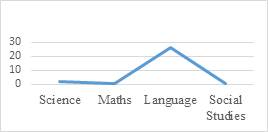
Figure
1. Subjects
taught in English
Note. The figure shows
the subject in which students have learned the most English. Source. Survey
applied to 1st. and 2nd. year Baccalaureate students from the UK School
Educational Unit (2022).
Findings indicated that students have learned English
the most in their language class, with 86.7%. Therefore, it can be deduced that
grammar, idioms, colloquialisms, and so forth have played a significant role in
learning the target language.
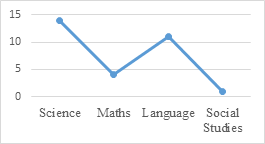
Figure 2. Vocabulary
difficulties.
Note. The chart shows the subject in
which students have had more vocabulary difficulties. Source. Survey applied to
1st. and 2nd. year Baccalaureate students from UK School
Educational Unit (2022).
Learners
found the Science class more challenging than the other subjects when learning
vocabulary (46.7%). Consequently, it can be deduced that complex scientific
vocabulary, such as the ones found in Math and Social Studies, is not as simple
as Language terminology.
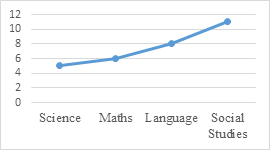
Figure 3. Motivation
Note. The line chart
shows the subject in which the students felt most
motivated. Source. Survey applied to 1st. and 2nd. year
Baccalaureate students from UK School Educational Unit (2022).
Students felt more encouraged in the Social Studies
classes with 36.7%. So, it can be inferred that history and current social
issues are far more amusing for them. Lastly, learners mentioned that their
teacher advocates more oral interaction such as conversations and group discussions
in Language with 43.3%. Thus, it can be inferred that the tutor prefers to make
students discuss topics concerned with the language field and that it is easier
to employ the lexicon of the Language subject rather than one of Science, Math,
and Social Studies.
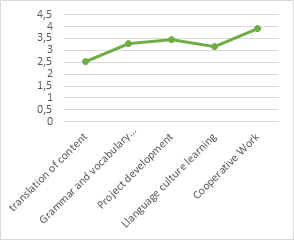
Figure 4. CLIL methodology
overview
Note. The figure shows how CLIL
methodology is implemented in the classroom. Source. Survey applied to 1st.
and 2nd. year Baccalaureate students from UK School Educational Unit
(2022).
Results
demonstrated that more than half of the content taught in classes is translated
into Spanish, with a mean of 2.53. Hence, it can be inferred that learners are
not used to complex terminology. That is why their teacher translates the
content to facilitate learning. Furthermore, there is a high emphasis on
grammar and vocabulary by the teacher, with a mean of 3.30. It can be assumed
that the curriculum expects students to dominate grammatical structures and
vocabulary. Moreover, learners develop a project at the end of each term, which
reflects that goals are planned for the long term because things cannot be
achieved overnight, with a mean of 3.47. In addition, English culture is
learned by students with a mean of 3.17. Thus, it can be assumed that the
institution really cares about preparing students to get used to the English
culture when they go abroad. Last but not least, learners work cooperatively
most of the time, with a mean of 3.93. So, it can be inferred that the teacher
is just a learning facilitator, and students are the ones who work together to
find solutions.
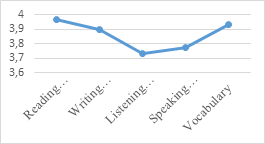
Figure
5. Development
of English language skills
Note. The chart shows the
skill that students developed the most. Source. Survey applied to 1st.
and 2nd. year Baccalaureate students from UK School Educational Unit
(2022).
Students
have improved their reading skills a lot by reading texts about Math, Science,
Language, and Social studies, with a mean score of 3,97. Consequently, students
have improved their performance in reading due to the variety of topics in the
different subjects. Additionally, their writing skills got better due to
writing paragraphs about the different subjects with a mean of 3,90. Thus, it
can be deduced that they have written a lot of paragraphs for each subject. As
a result, they comprehend the writing process very well. By comparison,
listening was the least upgraded skill, with a mean of 3,73. This can be caused
by a lack of exposure to different accents. In addition, students’ speaking
skills have improved due to talking about different subject topics, with a mean
of 3,77. Therefore, it can be inferred that students have been exposed to many
situations in which they have had to argue their points of view about the
different topics of the subjects. Finally, high schoolers have learned more
vocabulary due to their immersion in different classes, with a mean of 3,93.
Therefore, it can be deduced that the variety of terminology in each subject
has been quite fruitful for learning new words.
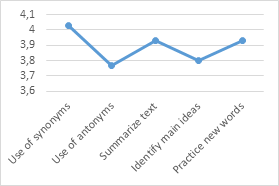
Figure
6. Vocabulary
learning strategies
Note. The graph displays
the most effective strategies and activities to learn vocabulary. Source.
Survey applied to 1st. and 2nd. year Baccalaureate
students from UK School Educational Unit (2022).
Findings
showed that within the memory strategies, it is easier for students to relate
information when they employ synonyms, with a mean of 4,03. In contrast to
that, it is more complex for them to learn new words when they use antonyms,
with a mean of 3.77. Hence, it can be assumed that similar terminology is
simpler than opposite stuff when relating information. Moreover, learners
dominate the cognitive activity of summarizing texts of the subjects taught in
English with a mean of 3,93. Additionally, within the metacognitive strategies,
students are able to identify the main ideas of a text with a mean of 3.80.
Therefore, it can be assumed that it is easy for them to find the most
important ideas and keywords to sum up different texts. In the last instance,
students learned more vocabulary by employing activation strategies such as
writing paragraphs with a mean of 3.93. Thus, it can be assumed that using the
new words in paragraphs helps them activate what they have learned previously.
DISCUSSION
CLIL
has relied on numerous theoretical sources and adapted its methodology to the
needs of 21st century students. CLIL is an ecological approach that combines
cultural, political, social, and environmental approaches to meet the needs of
language and content. Although there are some similarities with other bilingual
programs, language teaching approaches, and content-based language teaching,
there are identifiable traits that characterize CLIL as a unique approach.
Baranova et al. (2020), pointed out that CLIL is a model that increases the
level of motivation due to the employment of the target language in the context
of different thematic modules. In that regard, it was found that high schoolers
feel quite motivated when learning English with CLIL methodology. Particularly,
they feel more encouraged in their Language and Social Studies classes because
they address topics of social interest. Moreover, Verdugo (2011), claimed that
within the CLIL methodology, language develops oral communication skills. In that
sense, findings demonstrated that oral interaction, such as conversations and
group discussions, is definitely promoted in Language and Social Studies
classes. It is easier for learners to talk about current social topics and
language than complex issues related to Math and Science.
Coyle
et al. (2010), established that CLIL is not content teaching translated into a
different language (code) from the mother tongue. However, results demonstrated
that the teacher translates more than half of the content taught in the
different subjects, which is striking considering that the institution where
the research was conducted is a bilingual institution. Moreover, McDougald
(2018) claimed that schools need to plan for short, medium, and long-term goals
because those objectives cannot be achieved quickly. In that vein, it was found
that students develop a project at the end of each term for every subject they
take, which demonstrates that teachers definitely plan for long-term goals.
Genesee
(1994), suggested that students who are immersed in CLIL methodology can
demonstrate the same abilities, even beyond those of native speakers, in terms
of writing or speaking. In that regard, it was found that learners improved the
core skills of the English language by improving their reading, listening,
writing, and speaking skills about the different subjects. Finally, students
learned more vocabulary due to the content of the subjects.
Finally,
Schmitt (1997), divided strategies to learn vocabulary into memory, cognitive,
metacognitive, and activation. In that sense, it was found that students employ
them all to learn new words. Nevertheless, it is fundamental to highlight that
memory, cognitive, and activation strategies were the most used by high
schoolers. Using the memory strategy, learners relate words to their synonyms
and antonyms, employ new terminology in a sentence, and paraphrase. Moreover,
within the cognitive strategies, students summarize, synthesize, outline
information, and so forth. Lastly, within the activation strategies, they write
sentences using the new terminology they have just learned. On the other hand,
the metacognitive strategy was the least used. In other words, it was found
that it is still challenging for students to identify which words are crucial for
them to learn and to get the main idea of a determined passage.
CONCLUSIONES
Students
feel more motivated to learn English when they find opportunities to employ the
language and are exposed to oral interaction and group discussions about
interesting current social issues.
Learners
develop a project at the end of each term, to even more expose them to the
target language. Teaching about culture prepares students to go abroad.
Students’ role is active since they are the ones who work together in order to
find solutions.
Students’
linguistic skills and vocabulary improved because they had a lot of practice
reading, listening, writing, and speaking, but they still need more exposure to
listening skills.
Memory
strategies are the best for students when they want to relate information
because they can employ synonyms. By contrast, it is more complex for them to
learn new words when they use antonyms. Moreover, learners could summarize
texts, identify main ideas, and learn more vocabulary by employing activation
strategies such as writing paragraphs.
CONTRIBUTION
OF THE AUTHORS
The
contribution made in this study all researches played a fundamental role in the
development of the investigation those are: Marbella Cumandá Escalante Gamazo, Erick
Patricio Arias Quinga, Xavier Sulca Guale y Dorys Cumbe.
ACKNOWLEDGMENTS
Thanks
to Universidad Técnica de Ambato Facultad de Ciencias Humanas y de la Educación
además a la Carrera de Pedagogía de los Idiomas Nacionales y Exranjeros y a la
Unidad Educativa UK.
BIBLIOGRAPHIC
REFERENCES
Afzal,
N. (2019). A study on vocabulary-learning problems encountered by BA English
majors at the university level of education. Arab World English Journal (AWEJ)
Volume, 10. https://dx.doi.org/10.2139/ssrn.3465990
Baranova, T., Khalyapina, L., Vdovina, E., & Yakhyaeva, C.
(2020, September). Soft CLIL v. 2.0: Integrating a mobile app and professional
content into the language training. In IOP Conference Series: Materials Science
and Engineering (Vol. 940, No. 1, p. 012140). IOP Publishing.
https://iopscience.iop.org/article/10.1088/1757-899X/940/1/012140/pdf
Coyle,
D., Hood, P., & Marsh, D. (2010). CLIL.
https://clilrb.ucoz.ru/_ld/0/29_CLILPlanningToo.pdf
Genesee,
F. (1994). Integrating language and content: Lessons from immersion. https://escholarship.org/uc/item/61c8k7kh
McDougald,
J. S. (2018). CLIL across the Curriculum, benefits that go beyond the classroom.
Latin American Journal of Content & Language Integrated Learning, 11(1).
https://laclil.unisabana.edu.co/index.php/LACLIL/article/view/9679/pdf
Sanad, H. A.,
& Ahmed, M. G. (2018). Using content and language integrated learning
(CLIL) to develop EFL reading comprehension skills, vocabulary skills
, Erick
Patricio Arias Quinga1
, Xavier
Sulca Guale1